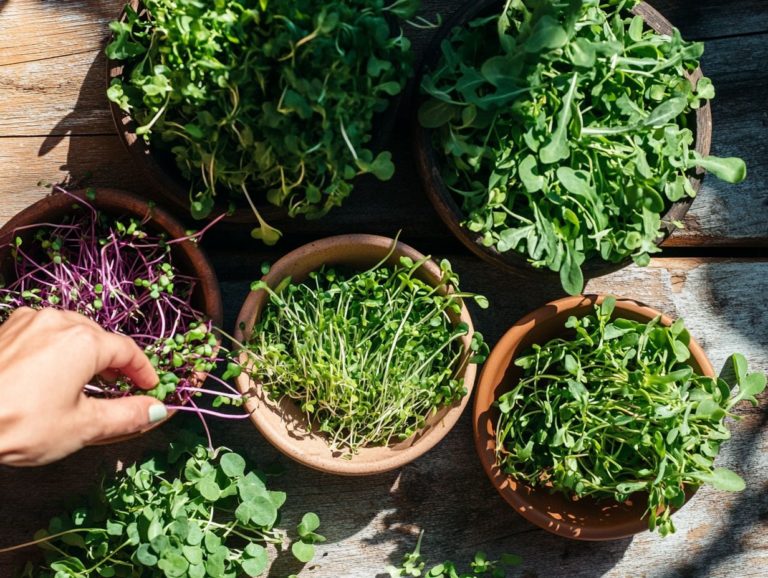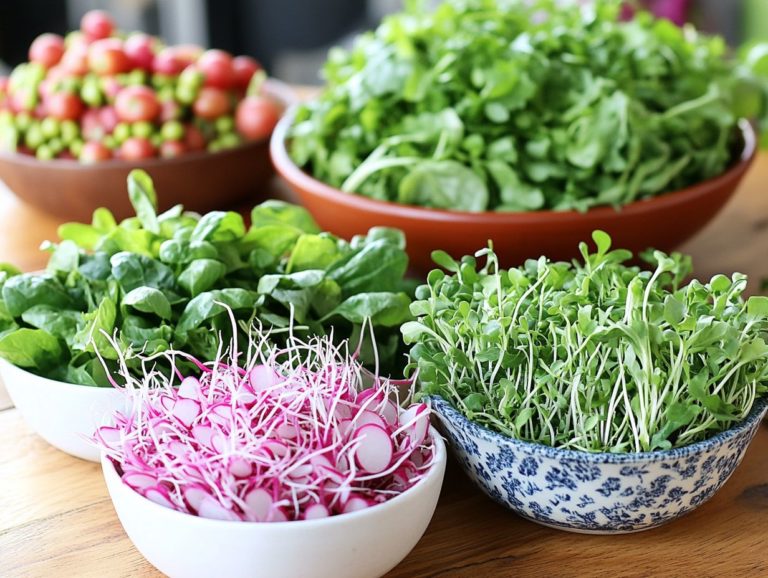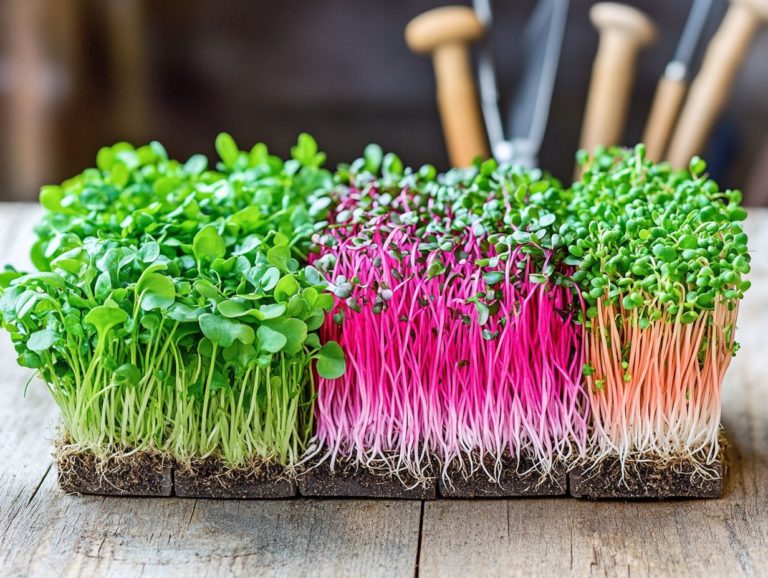5 Microgreens for Enhancing Eye Health
Microgreens are small seedlings full of nutrients that deliver a strong punch of flavor and health benefits.
Among them, five exceptional varieties broccoli, kale, spinach, pea, and sunflower microgreens are particularly noteworthy for their contributions to eye health.
Discover the essential nutrients these greens offer, learn how to easily incorporate them into your meals, and consider any precautions that may apply. You ll also find delicious recipes that highlight these vibrant, flavorful greens.
By embracing these mini marvels, you can boost both your diet and your eye health!
Contents
- Key Takeaways:
- 1. Broccoli Microgreens
- 2. Kale Microgreens
- 3. Spinach Microgreens
- 4. Pea Microgreens
- 5. Sunflower Microgreens
- What Are Microgreens and How Do They Benefit Eye Health?
- Frequently Asked Questions
- What are microgreens and how do they enhance eye health?
- What are the top 5 microgreens for enhancing eye health?
- How do broccoli microgreens benefit eye health?
- What eye conditions can kale microgreens help with?
- How can spinach microgreens improve eye health?
- Why are red cabbage microgreens beneficial for eye health?
Key Takeaways:

- Broccoli microgreens are rich in antioxidants and beta-carotene, helping to protect against age-related eye diseases.
- Kale microgreens contain lutein and zeaxanthin, which can improve vision and guard against cataracts and macular degeneration.
- Spinach microgreens are a great source of vitamin A, essential for maintaining healthy eyesight and preventing night blindness.
1. Broccoli Microgreens
Broccoli microgreens are a nutritious powerhouse, packed with concentrated nutrients that can elevate your health. These tiny greens offer many benefits, including high levels of antioxidants, vitamins A and C, and dietary fiber key components for a balanced diet and for fighting chronic diseases like cancer and Type 2 diabetes.
Research from the Cleveland Clinic highlights the effectiveness of these microgreens, especially their rich content of sulforaphane. This remarkable compound is celebrated for its cancer-fighting properties, showing promise in slowing the growth of cancer cells and aiding your body’s detoxification processes. Additionally, incorporating 5 microgreens to boost your metabolism can further enhance your overall health.
Adding broccoli microgreens to your diet could enhance insulin sensitivity, a crucial part of metabolic health. Studies also suggest that their high antioxidant content may help reduce oxidative stress, further aiding in the prevention of chronic diseases.
By including these microgreens in your meals, you not only introduce a burst of flavor but also actively support your long-term health strategy.
2. Kale Microgreens
Kale microgreens are often hailed as a superfood, and rightly so. They re loaded with health benefits, including antioxidants, vitamin K, and omega-3 fatty acids that promote eye health and may help alleviate iron deficiency.
These tiny greens also add flavor and nutrition to your meals. Their rich content of vitamins A and C, along with essential fatty acids, work together to boost your overall wellness.
Incorporating kale microgreens into your balanced diet can significantly improve your nutritional intake, making them an excellent choice for anyone looking to elevate their vitamin levels. To explore more options, check out the top 5 microgreen varieties for breakfast. Their iron content is crucial for preventing anemia, and the antioxidants they contain help combat age-related macular degeneration, supporting long-term eye health.
Embracing these microgreens is not just a culinary choice; it s a smart step toward enriching your diet and reducing potential health risks.
3. Spinach Microgreens
Spinach microgreens are a fantastic addition to your meals, offering a substantial dose of vitamin K and beta-carotene that brings numerous health benefits, including improved eye health and enhanced antioxidant properties.
These small greens deliver a nutritional kick, rich in vitamins A, C, and E essential for a strong immune system and overall well-being. For an even deeper dive, check out 7 microgreens packed with vitamins. Their delicate flavor and tender texture make them easy to add to salads, blend into smoothies, or use as a garnish for soups and sandwiches.
By incorporating spinach microgreens into your daily meals, you can boost heart health and reduce inflammation while adding vibrant color and a nutritional lift that supports a balanced diet. Loving these nutrient-dense greens allows you to significantly enhance your meals while enjoying the many benefits that lead to a healthier lifestyle!
Don’t miss out on the chance to improve your health. Start adding these nutritious greens to your meals today!
4. Pea Microgreens
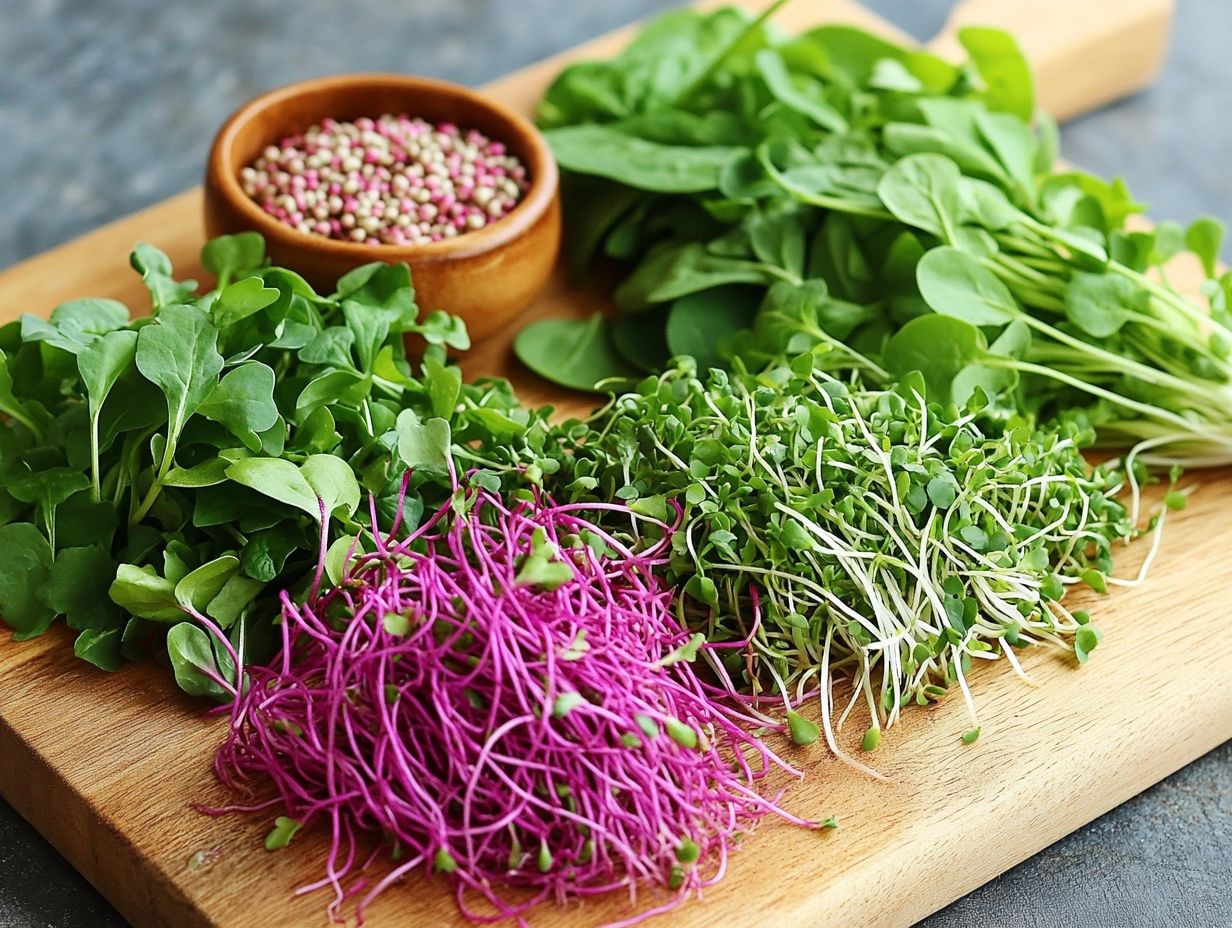
Pea microgreens, with their crisp flavor and vibrant color, are more than just a tasty addition to your meals; they re a powerhouse of protein and dietary fiber. If you’re looking to elevate your health through a plant-based diet, these greens are a great choice.
Often overlooked, these tiny wonders boast an impressive nutritional value that delivers a significant boost in essential amino acids. Their rich fiber content supports digestive health and keeps you feeling full, making them a smart addition if you’re aiming to manage your weight.
Research suggests that incorporating these greens into your meals can promote better glucose regulation, which is especially beneficial for anyone managing metabolic conditions like diabetes. So, whether you toss them into salads or blend them into smoothies, you not only get to enjoy their delightful taste but also tap into their health-boosting benefits for a balanced and nutritious lifestyle. Start enjoying these greens today for a healthier you!
5. Sunflower Microgreens
You will love adding sunflower microgreens to your dishes! They are a delightful addition to your culinary repertoire, celebrated for their impressive nutritional value. Packed with Vitamin E and Zinc, these tiny greens are essential for promoting overall health and combating oxidative stress, as antioxidants help protect your body from damage.
But that s not all they also deliver a generous dose of Vitamin C and Magnesium, both vital for bolstering your immune system. Incorporating sunflower microgreens into your daily meals is easy; simply toss them into salads, blend them into smoothies, or use them as a vibrant garnish for soups and sandwiches. They elevate both the flavor and nutritional value of your dishes.
This remarkable blend of vitamins and minerals not only enhances immunity but also supports skin health and aids muscle function. Sunflower microgreens are truly a powerhouse ingredient for anyone eager to optimize their diet, especially when considering 7 microgreens for a boost in vitality.
What Are Microgreens and How Do They Benefit Eye Health?
Microgreens are young, edible plants that you harvest just after the first true leaves have developed. They play a vital role in promoting eye health because they contain nutrients like Lutein and Zeaxanthin. These nutrients are crucial for combating age-related macular degeneration and enhancing overall vision.
Typically grown in well-drained soil or without soil, microgreens thrive under optimal light conditions for a brief period, usually between 7 to 21 days. Among the various types, Kale, Spinach, and Swiss chard stand out for their rich antioxidant content, which helps protect your eyes from harmful free radicals. Additionally, incorporating these greens into your diet can enhance cognitive function, as highlighted in 5 ways microgreens promote mental clarity.
By incorporating these flavorful microgreens into your daily meals, you can significantly elevate your intake of vital compounds, improving retinal health and safeguarding against vision degeneration. With their delicate textures and intense flavors, microgreens not only enhance the nutritional value of salads, sandwiches, and smoothies but also add a delightful culinary flair.
What Nutrients Do These Microgreens Contain?
Microgreens are a treasure trove of concentrated nutrients, brimming with an impressive array of vitamins, minerals, and antioxidants that can enhance your diet significantly.
These young plants, typically harvested just after their first true leaves emerge, deliver a remarkable nutritional punch. Take varieties like Broccoli and Kale, for example; they are loaded with vitamins A, C, and E, which are essential for robust immune function and glowing skin.
Omega-3 fatty acids in microgreens such as Sunflower promote heart health and help reduce inflammation, while the dietary fiber present in many types supports digestion and fosters a satisfying sense of fullness.
Incorporating these tiny, flavorful greens into your meals can elevate not only your culinary experience but also your overall well-being, paving the way for a vibrant and balanced lifestyle.
How Can These Microgreens Be Incorporated into One’s Diet?
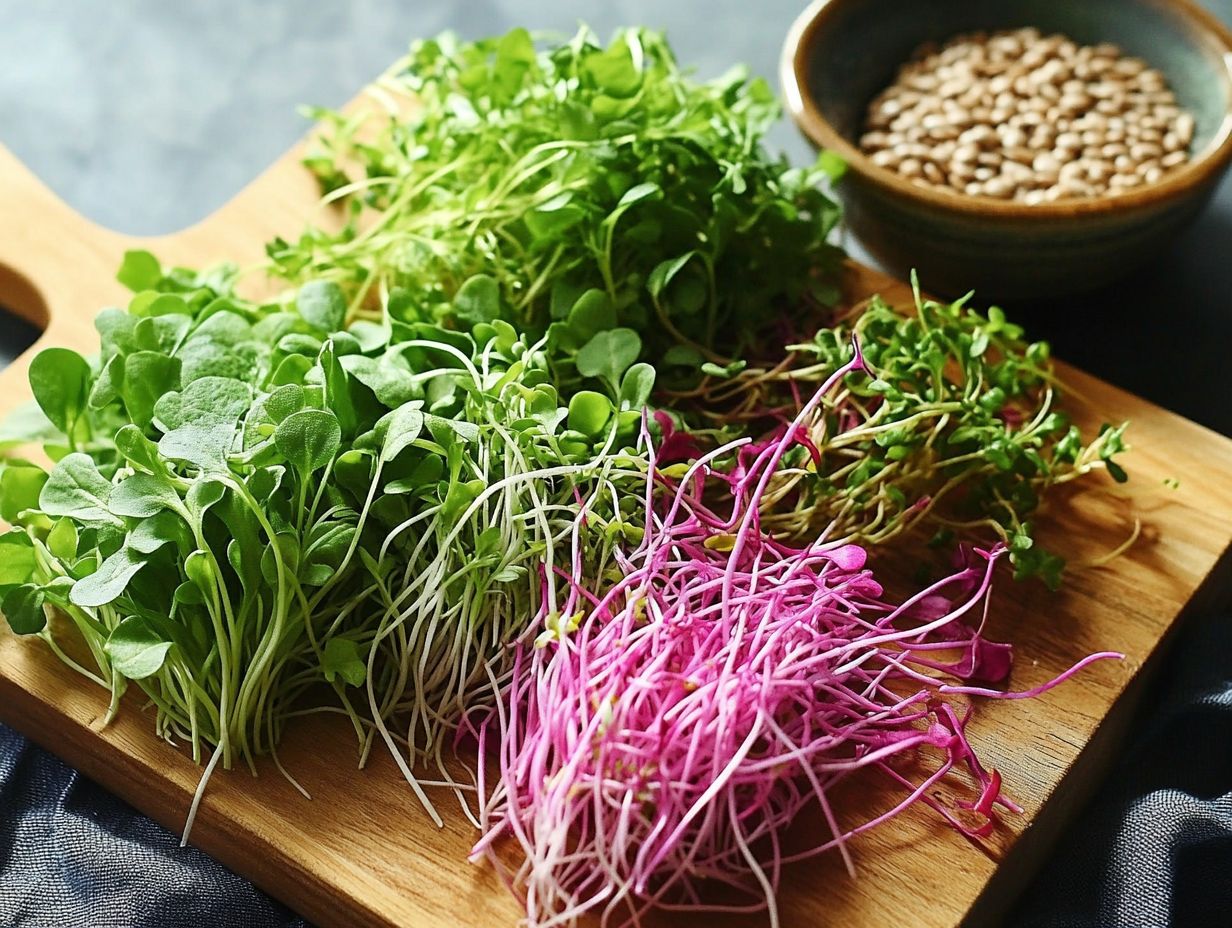
Adding microgreens to your diet is simple and rewarding. They boost flavor and nutrition in dishes like salads and smoothies.
These tiny, nutrient-packed greens bring a delightful burst of color, texture, and taste that elevates almost any meal. For example, sprinkle a handful of radish microgreens on classic avocado toast for a zesty kick. A mix of basil and pea shoots can elevate your pasta to new culinary heights. To discover more about how microgreens can enhance your energy levels, check out 5 microgreens to boost energy levels.
You can blend them into your morning smoothie for a vitamin surge or toss them into a stir-fry for an unexpected crunch. Their versatility makes them ideal for various cuisines, whether adding freshness to a Mediterranean salad or enhancing the savory flavor of Asian-inspired dishes.
Unlock the exciting potential of microgreens. They will transform your meals into vibrant culinary adventures!
Are There Any Precautions to Take When Consuming Microgreens?
While microgreens boast many health benefits, it s essential to take certain precautions to mitigate potential health risks, particularly those related to food safety and contamination.
Always use proper washing techniques before consumption. A thorough rinse under running water can effectively remove dirt, pesticides, and pathogens. Storing microgreens in a cool, dry place is crucial for prolonging their freshness and preventing harmful bacteria growth.
Be aware that some varieties, like radish and sunflower microgreens, may carry specific health risks, including exposure to harmful pathogens like E. coli and Salmonella. However, incorporating 5 microgreens that support healthy aging into your diet can provide numerous benefits. Enjoy them shortly after purchase and avoid any with visible decay for a safe dining experience.
What Other Health Benefits Do These Microgreens Offer?
Beyond their well-known nutritional benefits, microgreens offer additional health advantages, including contributions to cancer prevention and the management of metabolic diseases.
These tiny greens are rich in vitamins and minerals and loaded with antioxidants believed to combat oxidative stress, which is linked to cancer. Research highlights specific microgreens like broccoli and radish, showing promise in inhibiting cancer cell growth in lab studies, including nutritious microgreen varieties for smoothies.
Their high fiber content supports metabolic health by improving digestion and regulating blood sugar levels. Incorporating a variety of microgreens into your diet may lead to better overall health outcomes. For example, including the top 10 microgreens for nutritional boost can enhance your well-being significantly.
What Are Some Delicious Recipes Using These Microgreens?
Creating delicious recipes with microgreens is a brilliant way to elevate your meals. They offer an explosion of flavor and a significant nutritional boost that aligns perfectly with a healthy lifestyle.
These tiny greens aren’t just for decoration; they pack a concentrated punch of vitamins, minerals, and antioxidants. Picture a vibrant salad crowned with microgreens or a hearty sandwich layered with their fresh crispness.
Imagine a nutrient-rich smoothie blended to perfection. Each variety, whether it s the peppery kick of arugula or the sweet whisper of basil, brings its unique taste and benefits.
This encourages you to embrace a creative and invigorating approach to nutritious eating that feels both refreshing and exciting.
Frequently Asked Questions
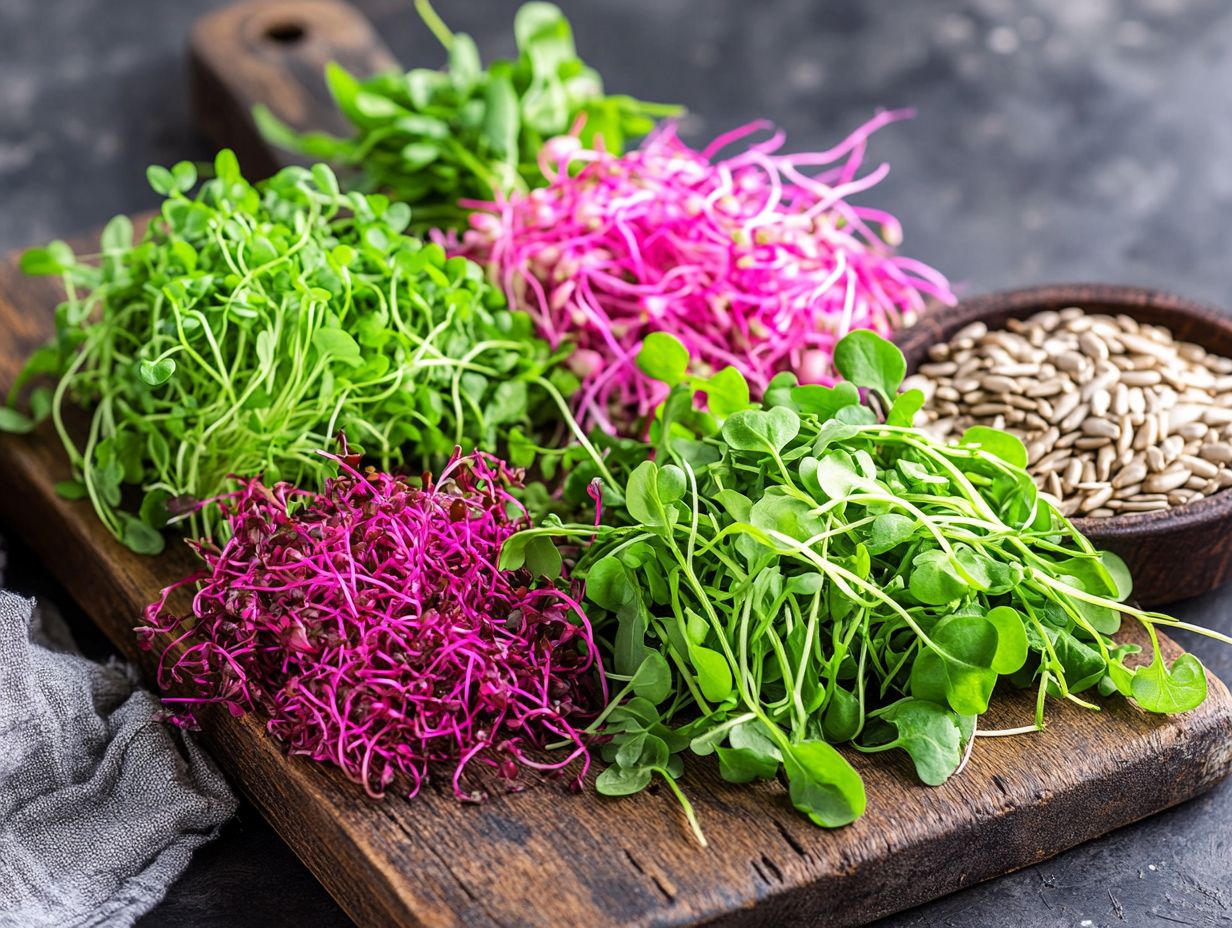
What are microgreens and how do they enhance eye health?
Microgreens are young vegetable greens harvested after the first primary leaves develop. They are packed with nutrients beneficial for eye health, including beta-carotene, lutein, and zeaxanthin.
What are the top 5 microgreens for enhancing eye health?
Boost your eye health today with these fantastic microgreens: broccoli, kale, spinach, red cabbage, and watercress. They are packed with antioxidants and essential nutrients.
How do broccoli microgreens benefit eye health?
Broccoli microgreens are rich in sulforaphane, an antioxidant that protects against cellular damage. They also have lutein and zeaxanthin, which are vital for healthy vision.
What eye conditions can kale microgreens help with?
Kale microgreens lower the risk of age-related macular degeneration and cataracts. They also help shield the retina from harmful UV rays.
How can spinach microgreens improve eye health?
Spinach microgreens are an excellent source of beta-carotene. This nutrient converts into vitamin A, crucial for clear vision.
Why are red cabbage microgreens beneficial for eye health?
Red cabbage microgreens contain anthocyanins, which combat age-related eye issues. They are also high in vitamin C, promoting healthy blood vessels in the eyes.



